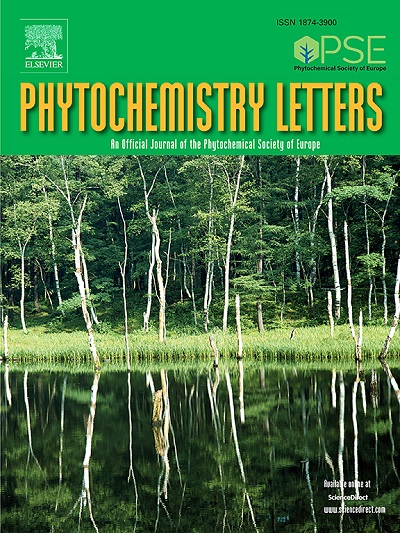具有Keap1结合亲和性的山茱萸倍半萜类化合物:化学多样性和生物活性筛选
IF 1.4
4区 生物学
Q4 CHEMISTRY, MEDICINAL
引用次数: 0
摘要
通过植物化学研究,分离鉴定了20个倍半萜类化合物(1 - 20),其中包括一个新的德国萜类衍生物(1)和5个同源物(6、10-11和14-15)。基于NMR、HRESIMS和ECD分析的结构解析将这些化合物分为5个不同的化学亚型:德国烷(1-6)、桉树烷(7-16)、银创烷(18-19)、椴树烷(17)和榄香烷(20)。为了评估其潜在的生物活性,以kelch样ech相关蛋白1 (Keap1)为靶蛋白,进行亲和超滤筛选(AUS)试验,结合超高效液相色谱-质谱(UPLC-MS)分析。结果表明,14个化合物与Keap1具有显著的结合亲和力。分子对接研究进一步表明,化合物2、4和8表现出最强的相互作用,结合能分别为−9.6、−9.2和−8.6 kcal/mol。这些化合物主要通过与残基ASN-414、ARG-415、VAL-465和ILE-559之间的氢键作用与Keap1相互作用,并与残基ALA-366、GLY-367、GLY-464、GLY-558和ILE-559之间的疏水相互作用。这些发现提示,这些倍半萜类化合物可能通过调节Keap1-Nrf2信号通路发挥抗氧化和神经保护作用,为揭示聚草属植物的药理潜力提供了新的思路。本文章由计算机程序翻译,如有差异,请以英文原文为准。
Sesquiterpenoids from Lindera aggregata with Keap1 binding affinity: Chemical diversity and bioactivity screening
Phytochemical investigation of Lindera aggregata roots led to the isolation and identification of 20 sesquiterpenoids (1–20), including a new germacrane-type derivative (1) and five congeners (6, 10–11, and 14–15) reported for the first time in this genus. Structural elucidation, based on NMR, HRESIMS, and ECD analysis, classified these compounds into five distinct chemical subtypes: germacrane (1–6), eudesmane (7–16), guaiane (18–19), lindenane (17), and elemane (20). To assess their potential bioactivity, an affinity ultrafiltration screening (AUS) assay, coupled with ultra-performance liquid chromatography-mass spectrometry (UPLC-MS) analysis, was performed using Kelch-like ECH-associated protein 1 (Keap1) as the target protein. The results indicated that 14 compounds exhibited significant binding affinity to Keap1. Molecular docking studies further revealed that compounds 2, 4, and 8 displayed the strongest interactions, with binding energies of −9.6, −9.2, and −8.6 kcal/mol, respectively. These compounds primarily interact with Keap1 through hydrogen bonding with residues ASN-414, ARG-415, VAL-465, and ILE-559, and hydrophobic interactions with residues ALA-366, GLY-367, GLY-464, GLY-558, and Ile-559. These findings suggested that these sesquiterpenoids may exert antioxidant and neuroprotective effects by modulating the Keap1-Nrf2 signaling pathway, providing new insights into the pharmacological potential of L. aggregata.
求助全文
通过发布文献求助,成功后即可免费获取论文全文。
去求助
来源期刊

Phytochemistry Letters
生物-生化与分子生物学
CiteScore
3.00
自引率
11.80%
发文量
190
审稿时长
34 days
期刊介绍:
Phytochemistry Letters invites rapid communications on all aspects of natural product research including:
• Structural elucidation of natural products
• Analytical evaluation of herbal medicines
• Clinical efficacy, safety and pharmacovigilance of herbal medicines
• Natural product biosynthesis
• Natural product synthesis and chemical modification
• Natural product metabolism
• Chemical ecology
• Biotechnology
• Bioassay-guided isolation
• Pharmacognosy
• Pharmacology of natural products
• Metabolomics
• Ethnobotany and traditional usage
• Genetics of natural products
Manuscripts that detail the isolation of just one new compound are not substantial enough to be sent out of review and are out of scope. Furthermore, where pharmacology has been performed on one new compound to increase the amount of novel data, the pharmacology must be substantial and/or related to the medicinal use of the producing organism.
 求助内容:
求助内容: 应助结果提醒方式:
应助结果提醒方式:


